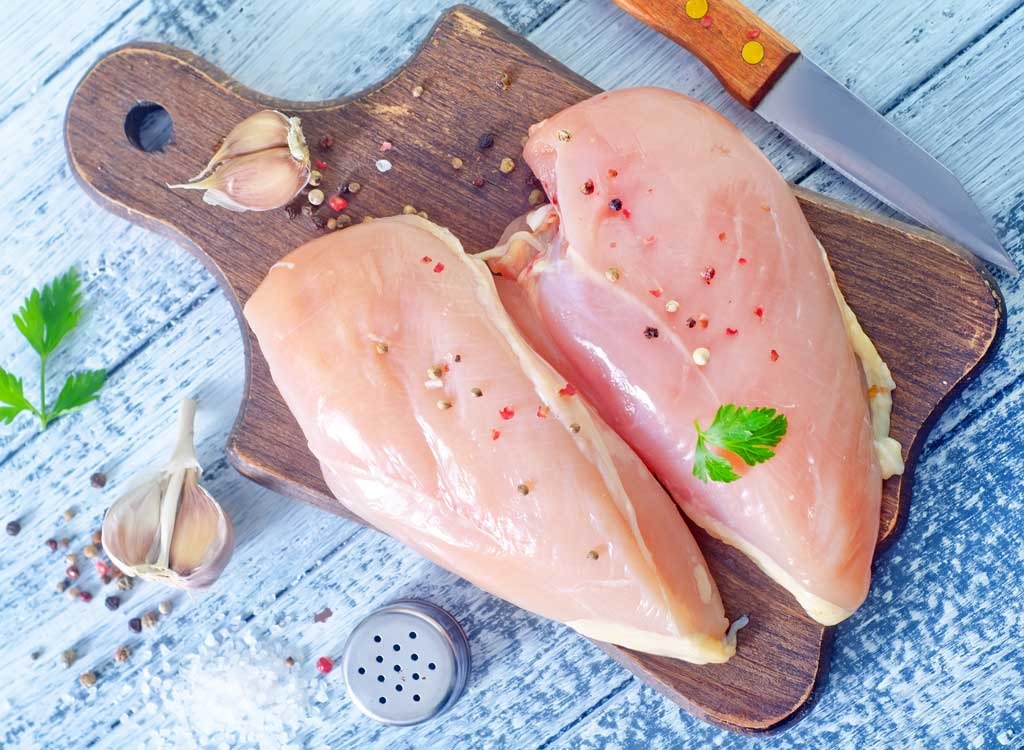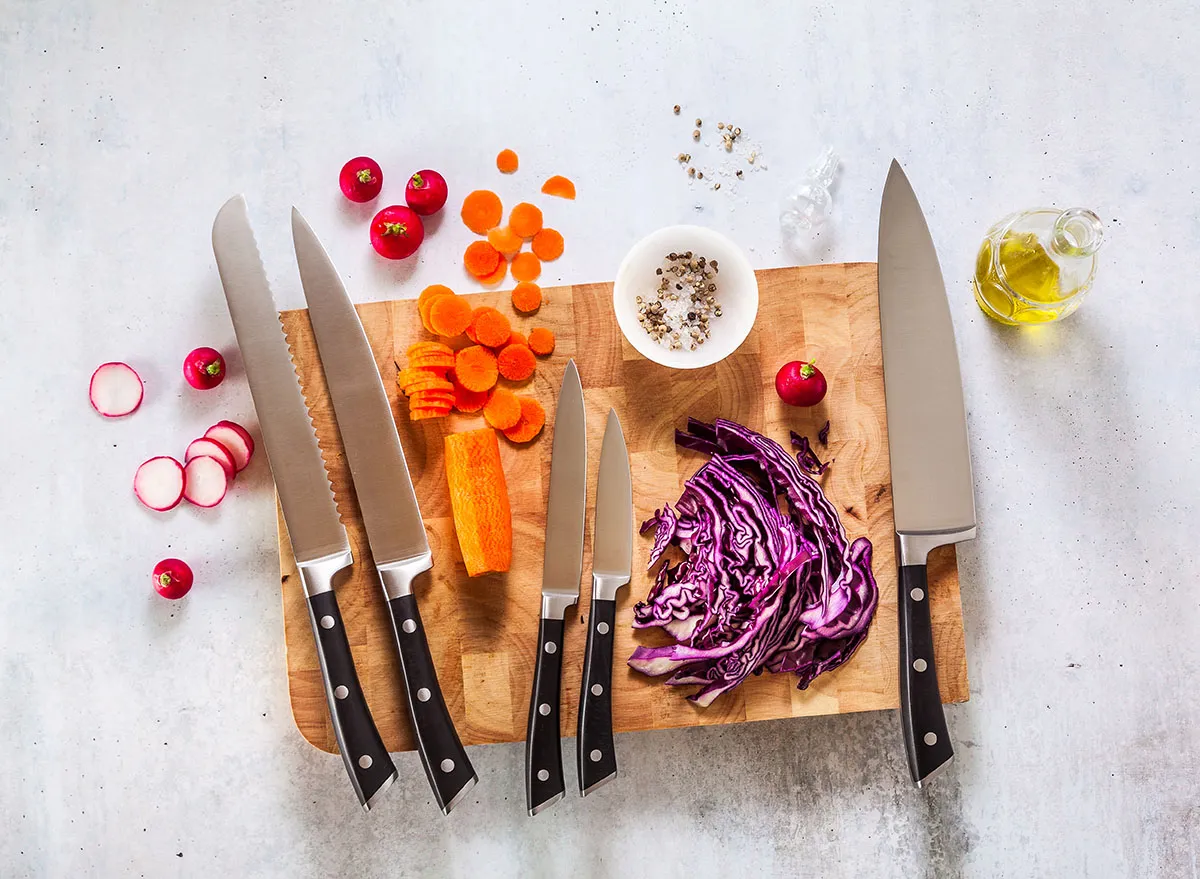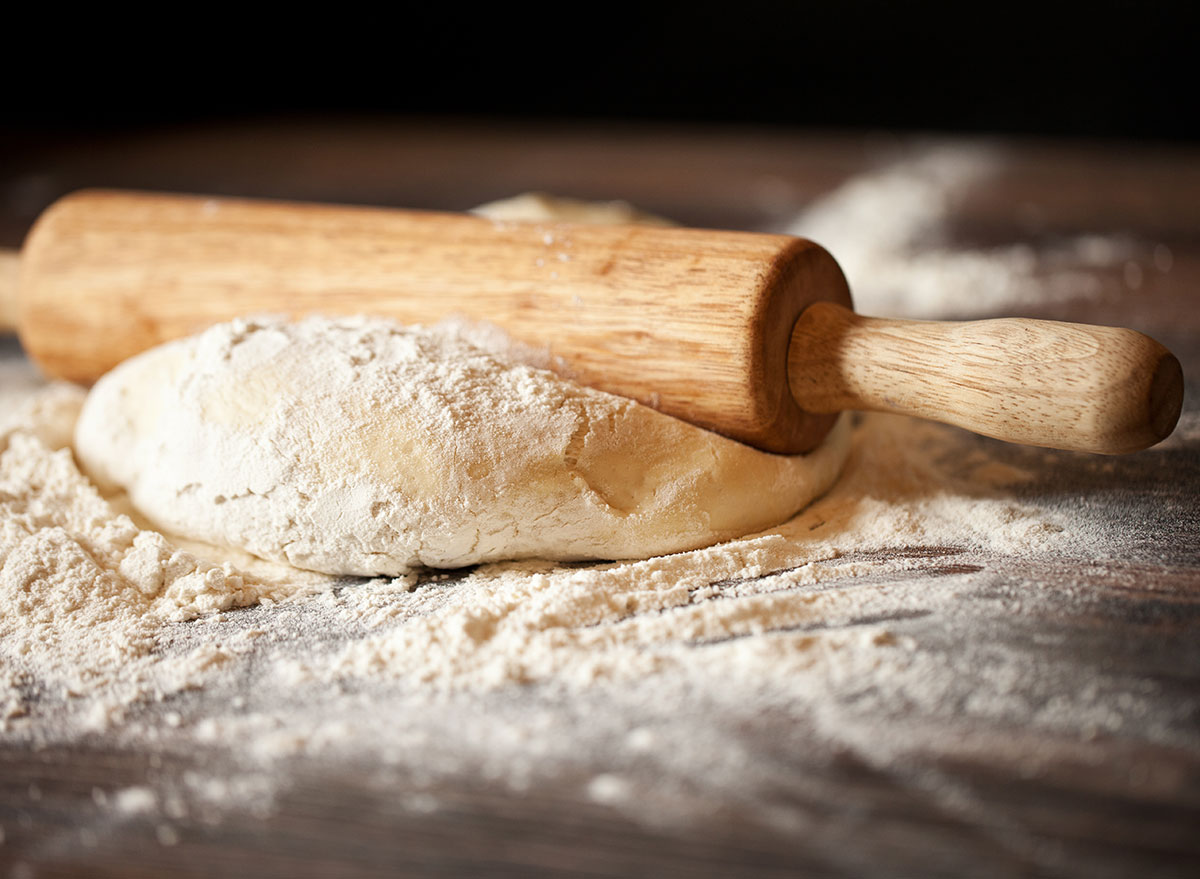40 Ways You’re Ruining Dinner Without Realizing It

Sure, no one is leaving Yelp reviews on your homemade dinners. Still, the pressure is on come mealtime, whether you’re cooking a meal for yourself, having a friend over for dinner, or feeding your entire family. You don’t want to spend an hour in the kitchen trying out a new recipe only to serve pasta that’s too starchy or a dried-out chicken dish. Or, maybe you’ve been avoiding that Instant Pot you bought after one too many dishes came out just so-so.
Truth be told, cooking is both an art and a science. It’s not hard to ruin a side of rice if you don’t get the water ratio just right. And your veggies, if you don’t boil or marinate them right, may turn out soggy.
Here are 40 common cooking mistakes that may be holding you back from those hypothetical five-star reviews. And for more, don’t miss these 15 Classic American Desserts That Deserve a Comeback.
Mistake: Not reading the whole recipe before you start cooking.

Lots of home cooks like to take a recipe one step at a time, says Laura Miner, who runs the recipe site Cook at Home Mom. But when you go this route, you may accidentally overlook some important information.
How to fix it: Spend a few minutes reading the full recipe from start to finish, says Miner. “The recipe will give you helpful information about the ingredients, prep, and the equipment you need, but it also may include terms you’re unfamiliar with that you need to look up.”
Mistake: Thawing meat on your counter.

Thawing raw meat can take hours, and bacteria will grow on meat just like any other perishable food, says Katie Heil, a certified food safety professional at StateFoodSafety. “In fact, if you leave meat out too long, not even cooking it will make it safe to eat,” she says.
How to fix it: You’ve got a few options for thawing meat. Thawing it in the refrigerator is the safest method, but is the most time-consuming, Heil says. Plan on one day of thawing per five pounds of meat.
You can also leave your meat in its original packaging and submerge it completely in cold water, she says. She recommends replacing the water in the sink every 30 minutes. Plan on two and a half hours of thawing for every five pounds of meat.
Or, you can go the microwave route (but proceed with caution, because we’re going to dig into why this isn’t the greatest method).
Mistake: Defrosting food in a microwave.

Truth be told, a lot of home cooks aren’t too familiar with the defrost function on their microwaves, says food scientist Kurt Anderson, also the owner of Pretty Great Cheesecake. “Most of the time, meat ends up partially cooked on the outside and raw on the inside,” Anderson says. “Essentially, you’re cooking the meat twice, leaving it dry and tough.”
How to fix it: While it takes longer, it’s best to plan ahead and thaw your meat in the refrigerator or even the sink.
But if you do thaw your food in the microwave, make sure it’s on a microwave-safe dish so that it catches the juices as it thaws, Heil says. Closely follow the instructions on your microwave for thawing meat.
Mistake: Not cooking food long enough.

Poultry needs to reach at least 165 degrees Fahrenheit, and seafood and ground meat should be at least 155 degrees Fahrenheit, according to StateFoodSafety. “Cooking food to proper temperatures kills potentially dangerous bacteria,” says Heil.
How to fix it: Don’t rely on how food looks to determine whether or not it’s done, Heil says. “The safest and easiest way to make sure your food is done is to use a food thermometer,” she says. Also, don’t forget to clean and sanitize the thermometer between uses.
Mistake: Improperly cooling your leftovers.

Meal preppers, you know the scenario: You cook a large batch of food for the week and then store it in the fridge. But the outside of the container will cool faster than the inside, and if the container is too large, bacteria can multiply to dangerous levels in the middle of the container where your food is still warm, Heil warns.
How to fix it: Divide your meals into smaller containers before refrigerating or freezing them, Heil suggests. “It may also be a good idea to leave the lids on your containers loose initially to allow steam to escape, and then fasten them properly after the food has cooled,” she says.
Mistake: Relying on regular salt.

Don’t default to table salt as your go-to. It can leave an acrid aftertaste, says Amanda Frederickson, author of the cookbook Simple Beautiful Food.
How to fix it: Switch to Kosher salt, Frederickson suggests. Kosher salt doesn’t dissolve as quickly as table salt does, so you can gradually salt your dishes.
Mistake: Turning or moving your food too often when it’s cooking.

It’s tempting to want to tend to your dishes. But, if you flip food too often or move your meal too often in the pan, it will never get a good sear or browning, Frederickson says.
How to fix it: If something is sticking to a pan, that means it is not ready to be flipped, even if there is olive oil or a fat in the bottom, she says. “Give it a couple more minutes of cooking, then try again, and you should be able to easily slide a spatula underneath and flip,” Frederickson says.
Mistake: Cutting your veggies unevenly.

When you cut your veggies unevenly, some of the smaller pieces will end up overcooked, making them taste soggy and flavorless, says Coleen Janeway, a chef and culinary alchemist with SkinFoodBodyLove.
How to fix it: Cut those veggies consistently! If you lack in the precision department, get some help from a vegetable slicer or dicer.
Mistake: Not using enough liquid in your Instant Pot.

Pressure cookers must have liquid, or else there will be no steam to create pressure, explains Miner. “If you don’t include enough liquid, the contents will scorch and your recipe will be a disaster,” she says.
How to fix it: Always include at least the minimum amount of liquid recommended, based on the size of your pressure cooker, Miner says. For a three-quart cooker, use at least a half cup of liquid; for a six-quart cooker, use at least one cup; and for an eight-quart cooker, use at least two cups.
Mistake: Using the Instant Pot’s quick-release method on meat.

The quick-release method is used by turning the knob on top of the Instant Pot from “Sealed” to “Venting,” Miner explains. It allows all the pressure and steam that’s built up to release quickly, which will cause meat to seize up. Doing this will ruin a roast because your meat needs time to rest in order to stay tender, she explains.
How to fix it: Ideally, you would allow your pressure cooker to release the pressure on its own. The Natural Release function though could take between 15 and 40 minutes, Miner says, depending on just how much pressure built up. “If time is a factor, you can allow the pressure to naturally release for at least 10-15 minutes, then turning the knob to release the remaining pressure using the Quick Release method,” she says.
Mistake: Not par-cooking bacon.

Bacon wrapped around shrimp, a ribeye or asparagus can take your dish up a notch. But, if you wrap the bacon when it’s raw, the bacon might cook unevenly, says Eliza Cross, author of 101 Things To Do With Bacon.
How to fix it: Arrange the strips of bacon on a parchment-lined baking sheet and cook them at 400 degrees Fahrenheit just until some of the fat is rendered and the sides are barely beginning to brown, Cross says. The bacon strips will still be flexible enough to wrap around your dish, she says.
Mistake: Boiling water incorrectly.

It’s an age-old conundrum: A watched pot never boils, but turn your attention from the boiling pot and it starts to spill over.
How to fix it: Try the wooden spoon trick, suggests Alexa Blay, the recipe developer and cook behind Key To My Lime, a budget-friendly recipe blog. When you place a wooden spoon over the pot of water, it stops it from boiling over because the spoon pops the bubbles.
Mistake: Over-seasoning your food.

Striking the just-right balance of seasoning your dish can be tough. But remember, it’s easier to add spices than it is to remove them, Blay says.
How to fix it: Season your food a little at a time, and taste it after every addition, Blay suggests. That way, you can adjust as you go along.
Mistake: Not preheating your cast-iron skillet before adding fat.

For your cast-iron skillet to be a non-stick surface, it needs to heat up before you add the oil, butter or lard, Blay says. The oil also needs to be hot before you add your food.
How to fix it: Luckily, the oil heats up very quickly when it’s added to a hot skillet. You can tell that the oil is hot because it becomes more shimmery and slick-looking, Blay says.
Mistake: Not seasoning your cooking water.

You toss your pasta or potatoes into plain ol’ water to boil. But, by doing this, you’re missing out on an opportunity to give them more flavor.
How to fix it: Salt the water that potatoes or pasta will be boiling in. “This seasons them from the inside out and gives you a flavorful and delicious dish,” Blay says. Add the salt after the water begins to boil. And don’t be skimpy: Salt that water like it’s the sea, and you can be especially generous with potatoes because they’re so dense.
Mistake: Boiling veggies incorrectly.

Did you know different boiling protocol applies to root vegetables like potatoes and above-the-ground veggies like corn? If you toss cold potatoes into hot boiling water, you get a mushy exterior because the starch gelatinizes, explains the Farmers’ Almanac. But if you put above-ground-veggies in cold water and let them boil for too long, they’ll become wilted or soggy.
How to fix it: When you cook above-ground vegetables, you just want to soften the cell walls, which is a pretty quick process. So, that’s why you should drop corn and other above-ground veggies into boiling water, according to the Farmers’ Almanac. But, potatoes and other root veggies have starches that need to dissolve before you eat them, and starting them off in cold water allows for more even cooking, the Farmers’ Almanac explains.
Mistake: Not rinsing canned beans.

When you open up a can of beans, they’re often in a cloudy liquid. Not only is it not appetizing, but that liquid can also add a whole lot of sodium and extra starches to your dish. Also, not rinsing canned beans can lead to a metallic taste for some, says Blay.
How to fix it: Unless the recipe calls for the liquid in the can of beans (this is sometimes the case in chili recipes with chili beans), go ahead and drain that liquid and rinse off your beans in a strainer. If you have plans to roast the beans, be sure to pat them dry so they can achieve a crunchy exterior in the oven.
Mistake: Draining all of your pasta water.

When you finish cooking pasta, don’t let all that pasta water filter out of the strainer. Saving some of that starchy, salty water will make your pasta sauce even better and can work as a thickening agent.
How to fix it: Reserve one half-cup of the pasta water, add it into your pasta sauce, and mix, suggests Blay. It will add flavor to your sauce, and it will also help your sauce stick to the pasta, she says.
Mistake: Skimping on oil.

A lot of recipes will say to only use a small amount of oil, points out Don Baiocchi, the recipe developer behind Paleo Gluten Free Guy. Searing or sautéing food in a too-dry skillet, though, creates dry, scorched food that often sticks to
the pan.
How to fix it: Start with a tablespoon of oil, or however much a recipe says or you think is necessary. But keep an eye on the pan, Baiocchi says. Adjust as you go. If you are worried about the food being too greasy, drain it on a paper towel-lined plate before serving, he suggests.
Mistake: Seasoning meat too late.

No one wants bland chicken or a flavorless steak! If you season proteins after you cook them, the salt and seasonings bounce off and won’t stick, says Frank Proto, director of culinary operations at the Institute of Culinary Education.
How to fix it: For flavorful main dishes, season your proteins right before you cook them, Proto says.
Mistake: Adding oil to water when you make pasta.

A lot of home cooks think you need to add oil to your boiling pot of water to prevent your pasta from sticking, Proto says. But the oil can make it tough for the sauce to stick to your pasta, he says.
How to fix it: Skip the oil. “Instead, just give your pasta a good stir a couple times after adding to the water to get it moving until the water starts to boil again,” he says. “You can stir a few times during the cooking process as well.”
Mistake: Adding pasta to water too soon.

Whether you’re making spaghetti, penne, macaroni, or any other pasta, one rule remains the same: Don’t add your pasta to cold water. Do this, and your pasta dish will be mushy.
How to fix it: Patience is a virtue when it comes to perfect pasta. Wait until the water is boiling (not just simmering) to toss in your pasta, Proto says.
Mistake: Not boiling pasta in enough water.

Pasta needs to have enough water so it’s not crowded in the pot and has space to move around, Proto says. Skimping on water will result in pasta that tastes gummy or starchy.
How to fix it: You want about four to six quarts of water for every pound of pasta, Proto says. If you’re using an eight-quart stockpot (usually the biggest pot in a home kitchen), you’ll want to fill it up at least halfway before boiling the water and adding in a pound of dry pasta.
Mistake: Marinating your seafood too long.

Marinades contain an acid, oil, and flavors and can impart a delicious flavor to shrimp and fish dishes. While you may be accustomed to marinating, say, brisket or a flank steak for up to 24 hours, fish and shrimp can’t be left to marinate that long. An acidic marinade will essentially “cook” the seafood, leaving it mushy.
How to fix it: You shouldn’t be marinating fish or shrimp for more than two hours, says Jess Dang, the founder of Cook Smarts, an online meal planning service. But, if you have a highly acidic marinade with ingredients like citrus or vinegar, you’ll want to marinate your fish or shrimp dishes for just 20 minutes, Dang says.
Mistake: Marinating veggies too long.

Not only does a marinade add extra flavor to everything from mushrooms to zucchini to eggplant, but it also helps caramelize your side dishes when cooked under high heat. But, marinating your veggies for too long can make them mushy because they’ll release water.
How to fix it: In general, Dang suggests marinating your veggies for just 30 minutes. Harder veggies like carrots, asparagus, bell peppers can stand up to the marinade longer than softer veggies, so go ahead and add those tomatoes or that broccoli into the marinade during the last 10 minutes.
Mistake: Not cubing your tofu.

Tofu does a great job absorbing the flavors of a marinade, but only if you remember a few key tricks. It won’t absorb the marinade easily if you don’t drain the liquid or if you try to marinate a full block of tofu.
How to fix it: Press the liquid from your tofu or let it drain on its own for 15 minutes or so, Dang suggests. Firm tofus do best with a marinade. You’ll want to slice or cube the tofu so it can best absorb the flavors, she says. Tofu can marinate for as little as 30 minutes to as long as 24 hours, according to Dang.
Mistake: Marinating in a metal bowl.

Most marinades contain an acid, and that will react with the metal imparting a metallic taste into your marinade, according to Beyond Meat’s marinating tips.
How to fix it: Instead, marinate in a plastic bag, plastic bowl, Tupperware, ceramic dish, or a deep plate, recommend the experts at Beyond Meat. Just avoid metal!
Mistake: Cooking white rice and brown rice the same way.

Brown rice and white rice need different water ratios when cooking. With brown rice, you need a little more water because its outer layer is still intact, explains Matt Slem, culinary scientist and rice expert at Lundberg Family Farms in Richvale, California.
How to fix it: “Typically for a white rice, I would recommend a 1:1.5 rice to water ratio. Brown rice needs a little more water, so a 1:1.75 rice to water ratio works well,” Slem says. “When in doubt, I’d recommend following the directions on the back of the package you bought.”
Mistake: Cutting meat too soon after you cook it.

As soon as the steak comes off the grill or the meatloaf is done in the oven, it may be tempting to slice into it and dig in. But, by doing this, you’ll release juices and dry out your meat, says Anderson.
How to fix it: Let your meat rest, Anderson says. This will help your meaty main dishes retain their flavors. How long to let your meat rest depends on the size of your cut, but in general you’ll want to give it at least five to 10 minutes, he says.
Mistake: Peeking at your rice as it cooks.

When you open up the lid to check in on your rice as it’s cooking, you release steam and heat, which can disrupt the rice to water ratio, says Denise Bustard, a professional food blogger at Sweet Peas & Saffron. As a result, your rice could end up hard rather than fluffy, she says.
How to fix it: Trust the process. Let your rice sit covered for 10 minutes after it’s done cooking (or however long your recipe suggests). Once it’s done, you can fluff it with a fork.
Mistake: Cutting your chicken breast open to see if it’s still pink.

“Slicing your chicken before it has properly rested can release the juices all over your cutting board, leaving you with dry, tough chicken,” Bustard says.
How to fix it: A better bet? Use a digital thermometer to check if your chicken has reached an internal temperature of 165 degrees Fahrenheit, she says.
Mistake: Not having a meal plan.

This is a big mistake because it can lead you to waste time trying to figure out what to cook for dinner, Bustard says. When your stomach is growling, you probably don’t have time to thaw out protein from the freezer or Google a new recipe and put in an Instacart order for the missing ingredients.
How to fix it: You don’t have to full-on meal prep. But having a basic meal plan in place for the busy work week will allow you to spring into action the moment you get home, and get dinner on the table quickly, Bustard says.
Mistake: Forgetting about carry-over cooking.

When you remove a dish you are cooking from the oven, grill or stove, don’t forget that it will continue cooking as it sits, Bustard says. If you forget to factor in carry-over cooking, your dish could end up dried out, she says.
How to fix it: As a rule, the larger the protein, the more it will continue to cook as it rests, Bustard says. Temperatures typically continue to rise between 10 and 20 degrees Fahrenheit once the food is removed from the oven or cooking area, so, again having a digital thermometer on hand can help you make sure your meals are reaching the right temp. “I like to undercook things like pork tenderloin or salmon ever so slightly because they will continue cooking as they rest and will be perfect to eat 5-10 minutes after removing,” she says.
Mistake: Not browning meat before you put it in the slow cooker.

It’s tempting to toss those roasts, chops, or chicken breasts directly into the slow cooker, and many recipes will suggest you do just that. But if you don’t brown or sear the meat first, your dish will miss out on some flavor, says Jill Winger, author of The Prairie Homestead Cookbook. Giving it a quick sear will help the meat develop a more complex flavor.
How to fix it: Heat your skillet over medium-high heat and add one to two teaspoons of cooking oil. Generously season the meat with salt and pepper, then carefully place it in the pan. Allow each side to brown for two to three minutes, flipping with a pair of tongs or spatula until a crust and a bit of color develops on all sides. You’re not looking to cook the meat through—we’re just creating that delicious crust on the outside, she says. Next, transfer the meat to your slow cooker and proceed with the recipe as usual.
Mistake: Baking a potato in aluminum foil.

If you wrap a potato in foil before you bake it, you’ll end up steaming it instead of baking it, according to the Idaho Potato Commission. You’ll get a soggy baked potato instead of the light fluffy one you’re craving to go alongside your dinner.
How to fix it: There’s no need to use foil. In fact, the foil will also increase cooking time, according to the Idaho Potato Commission. The best way to bake a potato is to do so for 55 to 60 minutes in a conventional oven at 425 degrees Fahrenheit. You want your baked potato to have an internal temperature of 210 degrees Fahrenheit.
Mistake: Over-mashing potatoes.

Starch is released when you mash your potatoes. If you go overboard and mash your potatoes too much, they’ll become too sticky with a glue-like texture, according to the Idaho Potato Commission.
How to fix it: Avoid using a mixer or food processor as these will over-mash your potatoes. To help get them extra fluffy, try adding a half teaspoon of baking powder to your mix, the Idaho Potato Commission suggests.
Mistake: Not letting avocados ripen enough.

Avocados are the perfect addition to a salad, taco, or ceviche. Let them get too ripe, and your avocado turns brown or even moldy. But if it’s too firm, it’s not tasty, either.
How to fix it: An avocado is perfectly ripe if there’s a slight give to pressure when you hold it in your hand. If it feels firm, leave it on the counter until it gives slightly to pressure, Whole Foods recommends. If you need to speed up the ripening process, try putting your avocados in a paper bag with a banana or an apple, the grocer recommends. Store the bag at room temperature on a counter or above your fridge.
Mistake: Always choosing lean ground beef.

Ground beef is a staple in many meals. While you may gravitate towards lean ground beef, not having enough fat can lead to a dry burger or meatloaf.
How to fix it: Ground beef that’s 93% lean or leaner works best in dishes that require crumbles, like a meat sauce, tacos, stuffed peppers or casseroles, according to “Beef. It’s What’s For Dinner,” which is managed by the National Cattlemen’s Beef Association. A mid-range lean-to-fat ratio like 80 or 85% is good for meatloaf or meatballs. Ground beef that’s 73 or 75% lean makes juicy burgers.
Mistake: Forgetting to preheat your oven.

Admittedly, this one is a bit of a no-brainer. But, foods cook faster in a preheated oven, and if you just pop your dish in the oven without preheating, it probably won’t come out as planned and will require some unnecessary guesswork.
How to fix it: It typically takes about 15 minutes for your oven to heat up, according to America’s Test Kitchen. In addition to following the pre-heating instructions, it’s also a good idea to make sure your oven racks are in place as the recipe suggests, the experts at America’s Test Kitchen say.
Mistake: Rolling your pizza dough.

Rolling your pizza dough with a rolling pin can crush the air pockets, preventing your dough from rising when you bake it.
How to fix it: Pizza makers aren’t just putting on a show when they hand toss pizza! Stretching the dough with your hands and hand tossing it will give it that fluffy, bubbly crust you expect from your pizza. Here are more mistakes that might be ruining your pizza night!
Keeping these easy, expert-approved tips in mind will help take your weeknight dinners to the next level. Never again will you need to order takeout because dinner went awry!